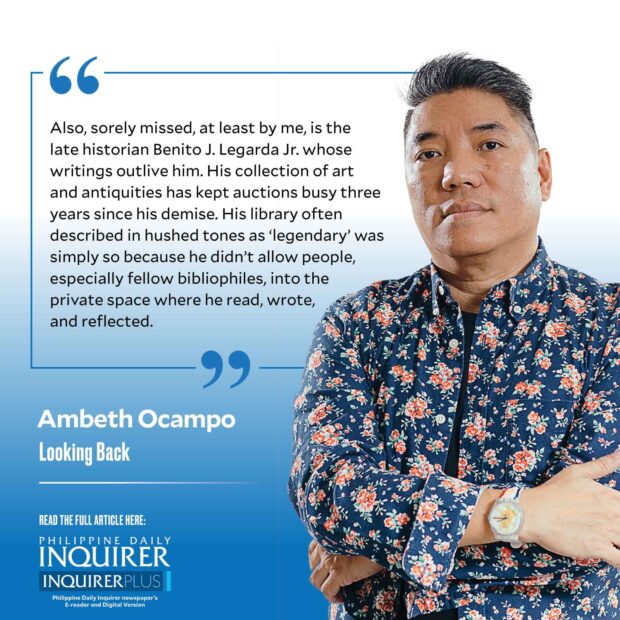
On the passing of Conrado de Quiros and Rina Jimenez David, someone commented that we were seeing “the end of an era.” I was tempted to reply that we already saw that when Letty Jimenez Magsanoc, the iconic Inquirer editor in chief, wrote 30 in 2015. The voices of Letty, Conrad, and Rina were sorely missed in the age of Rodrigo Duterte, more so in the unfolding of the second Marcos administration. Conrad and Rina will live on through published compilations of their columns and in the Inquirer online archive that will hopefully be completed someday like the New York Times “Times Machine.”
Also, sorely missed, at least by me, is the late historian Benito J. Legarda Jr. whose writings outlive him. His collection of art and antiquities has kept auctions busy three years since his demise. His library often described in hushed tones as “legendary” was simply so because he didn’t allow people, especially fellow bibliophiles, into the private space where he read, wrote, and reflected. If you can tell a person by the company he keeps, or by the food he eats, surely we can have a deeper knowledge of a person from the books he owned and read.
Two months ago, I walked through the United States Library of Congress, remembering the horde of Donald Trump hooligans that stormed the US Capitol to thwart the results of their presidential election. I was wondering what would have happened if they had stormed what is reputedly the largest library in the world. I went in search of the room where they displayed Thomas Jefferson’s library because his books formed the core of the Library of Congress. Walking around the glass cases gave me a sense of walking inside Jefferson’s mind. His books are arranged in the original order that he filed them, providing valuable insight into the way he ordered knowledge and the known universe.
The experience of seeing Jefferson’s books reminded me of one of my unfinished projects: to do a bibliographical essay on the books Andres Bonifacio and Jose Rizal owned and read, concluding with a reflection on what they were like in their world. Compared to Rizal’s library, the shelf list of the books Bonifacio kept in the bodega he managed as a stock clerk may be short in number, but not in significance. Bonifacio had books on the “French Revolution” and the “Lives of the Presidents of the United States.” Some of the books that both Bonifacio and Rizal owned were: the “Wandering Jew,” “Ruins of Palmyra,” and “Les Misérables.” Surely, this means something.
I may not have been physically inside Benito Legarda’s library, but the auction catalog of his important books is enough to give us a sense of what he read for work. A pity that a list of what he read for pleasure remains unknown. I was pleasantly surprised to learn that some of my newspaper columns were filed inside relevant volumes. For example, a column I wrote on Filipino pseudonyms was found inside bound issues of La Solidaridad.
The focus of the auction catalog is on works relating to the Philippines in the Spanish period, I am sure there is much more left over that cover the early American period. Since he wrote forcefully and passionately on surviving the Japanese Occupation of the Philippines, I wouldn’t be surprised if he had ready reference for it. On the block are 20th century editions and translations of earlier works whose original editions are rare and, if available at all, would be too expensive to acquire today. He had books relating to the people who figure in the birth of the nation: Isabelo de los Reyes, Pedro Paterno, Jose Rizal, Gregorio Sancianco, and even Ferdinand Blumentritt, a foreigner whose name is almost universally-known and recognized in the Philippines but forgotten in the Czech Republic, his birthplace. Paterno’s literary works “Sampaguitas,” a collection of poems and his novel “Nínay” (1885) that, contrary to popular belief, is the first Filipino novel, antedating Rizal’s “Noli Me Tángere” (1887). There are later editions of the “Noli” and “Fili,” 19th century travel guides of the Philippines, and valuable primary sources like firsthand accounts of the Philippine revolution against Spain.
If I win the lotto this week, what will I go for? The bound volumes of La Solidaridad will be one pick. One of my prized possessions is one single issue of La Solidaridad that I acquired from the late Armando J. Malay. I traded a duplicate copy of the revolutionary paper La Independencia, edited by Antonio Luna, for one of La Solidaridad edited by Marcelo H. del Pilar. What was my single copy compared to 92 issues bound in the Legarda collection? The other picks are 18th century works printed in Manila: first, the second volume of Pedro Murillo Velarde’s “History of the Philippines” (1749), that comes with a much sought after map of the Philippines that is often sold separately; second, is the 14-volume “Historia General de Filipinas” (1788) that also has maps sold separately.
Browsing over the Legarda catalog is déjà vu, I can imagine how my library will be auctioned off in the future.